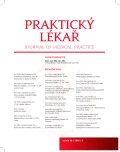Wagner’s model of chronically ill care
Authors:
Ľ. Tkáčová; D. Magurová; B. Grešš Halász; A. Hudáková
Authors‘ workplace:
Vedúca katedry: PhDr. Dagmar Magurová, PhD.
; Katedra ošetrovateľstva
; Fakulta zdravotníckych odborov
; Dekan: Dr. h. c. prof. PhDr. Anna Eliášová, PhD., DBA
; Prešovská univerzita v Prešove
Published in:
Prakt. Lék. 2018; 98(6): 257-259
Category:
Of different specialties
Overview
Chronic diseases markedly increase in the 21st century. In 1999, Wagner and colleagues presented perhaps the most influential theoretical model for the care of chronically ill- Chronic Care Model – CCM. The aim of this thesis is to describe the model of care for the chronically ill, its specific use in patients with diabetes mellitus as this disease has been the prototype for the model development. We refer to the issue of care for the chronically ill and the role that a nurse plays in it. Chronic care model has the potential to improve efficiency of management of patients with diabetes mellitus without adversely affecting the results of the patients.
KEYWORDS:
chronic disease – diabetes mellitus – CCM – health care
Sources
1. ADA. The Cost of Diabetes [on line]. Dostupné z: http://www.diabetes.org/advocacy/news-events/cost-of-diabetes.html [cit. 2018-09-21].
2. AIHW. Australia’s health 2012. Australia’s health series No 13. Cat. No. AUS 156. Canberra: AIHW 2012.
3. Bukovská A, Galajda P, Mokáň M. Vybrané problémy pri diabetes mellitus. Martin: Osveta 2015.
4. Clark NM. Management of chronic disease by patients. Ann Rev Public Health 2003; 24: 289–313.
5. Gemmil M. Research note: Chronic disease management in Europe. London: LSE 2008.
6. Hegyi L. Chronické choroby – zdravotný a sociálny problém 21. storočia. Bedeker zdravia 2013; 5: 1.
7. ICN. Poskytování kvalitní péče, služba komunitám. Péče o chronicky nemocné [on line]. Dostupné z: http://www.mzcr.cz/Odbornik/dokumenty/balicek-icn_3407_930_3.html [cit. 2018-09-21].
8. Macinko JA, Shi L, Starfield B, Wulu JT Jr. Income inequality and health: a critical review of the literature. Med Care Res Rev 2003; 60(4): 407–452.
9. Magurová D, Majerníková Ľ. Edukácia a edukačný proces v ošetrovateľstve. Martin: Osveta 2009.
10. Mendes EV. O cuidado das condições crônicas na atenção primária à saúde:o imperativo da consolidação da estratégia da saúde da família. Brasília: Organização Pan-Americana da Saúde 2012.
11. MZ SR. Strategický rámec starostlivosti o zdravie pre roky 2014–2030 [on line]. Dostupné z: http://www.health.gov.sk/?strategia [cit. 2018-09-21].
12. Nagyová I. Model zdravotnej starostlivosti o chronicky chorých z pohľadu verejného zdravotníctva. Posilňovanie systému verejného zdravotníctva. Košice: Equilibria 2011.
13. NCD Alliance. Healthy Planet, Healthy People: The NCD Alliance Vision For Health In the Post-2015. Development Agenda [on line]. Dostupné z: https://ncdalliance.org/resources/healthy-planet-healthy-people-the-ncd-alliance-vision-for-health-in-the-post-2015-development-agenda [cit. 2018-09-21].
14. Nolte E, McKee M. (eds.). Caring for people with chronic conditions: A health system perspective. Maidenhead: Open University Press 2008.
15. Pauwels R, Rabe K. Burden and clinical features of chronic obstructive pulmonary disease (COPD). Lancet 2004; 364 (9434): 613–620.
16. Repková K, Sedláková D. Zdravotné postihnutie a chronické neprenosné ochorenia v medzinárodnom a národnom kontexte. Bratislava: Kancelária Svetovej zdravotníckej organizácie na Slovensku 2014.
17. SACHO. Analýza trendov chronických ochorení a monitorovanie zdravotných indikátorov v kontexte 9 cieľov globálneho monitorovacieho rámca do roku 2025 [on line]. Dostupné z: http://www.hpi.sk/2015/02/analyza-trendov-chronickych-ochoreni-do-roku-2025/ [cit. 2018-09-21].
18. Svatová M, Cmorejová V, Balková D. Chronická choroba a jej sociálne dôsledky. Elan vital v priestore medzigeneračných vzťahov: zborník príspevkov z konferencie s medzinárodnou účasťou. Prešov: PU 2010.
19. Švec J, Czirfusz A, Bencová V, Krčméry V. Nová vlna pandémie: civilizačné choroby. Civilizačné ochorenia a ich vplyv na kvalitu života, zdravia a sociálno – ekonomickú oblasť. Prešov: ÚSVaZ 2014.
20. Wagner EH, Bennett SM, Austin BT, et al. Finding common ground: patient-centeredness and evidence-based chronic illness care. J Altern Complement Med 2005; 11(Suppl 1): S7–15.
21. Ward BW, Schiller JS, Goodman RA. Multiple chronic conditions among US adults: A 2012 update. Prev Chronic Dis 2014; 11: 1–4.
22. WHO. Chronic diseases in low and middle income countries [on line]. 2005. Dostupné z: http://www.who.int/chp/chronic_disease_report/media/Factsheet3.pdf [cit. 2018-09-21].
23. Wielawski IM. Improving chronic illness care [on line]. Dostupné z: http://www.improvingchroniccare.org/downloads/rwjf_anthology_icic.pdf [cit. 2018-09-21].
Labels
General practitioner for children and adolescents General practitioner for adultsArticle was published in
General Practitioner

2018 Issue 6
- Metamizole at a Glance and in Practice – Effective Non-Opioid Analgesic for All Ages
- What Effect Can Be Expected from Limosilactobacillus reuteri in Mucositis and Peri-Implantitis?
- Metamizole vs. Tramadol in Postoperative Analgesia
- Memantine in Dementia Therapy – Current Findings and Possible Future Applications
Most read in this issue
- Dark lesions in the oral cavity – differential diagnosis
- Surrogacy in the Czech Republic: current status and the responsibility of the general practicioner
- Use of telerehabilitation as a complement to regular rehabilitation care
- Analysis of the most common food-and water-borne diseases in the Czech Republic, 2007–2017
